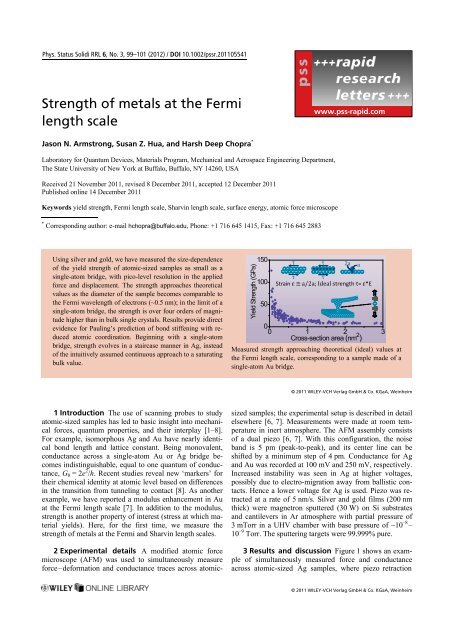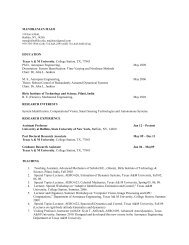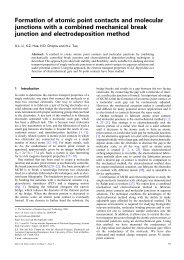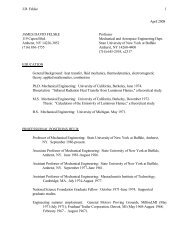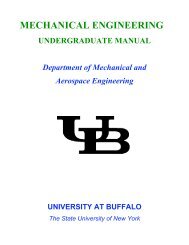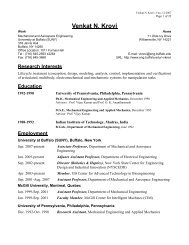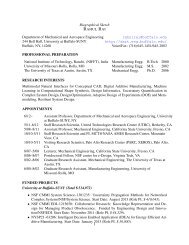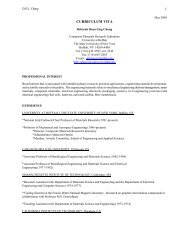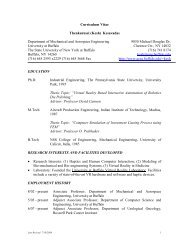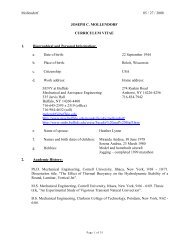physica status solid.. - Mechanical and Aerospace Engineering
physica status solid.. - Mechanical and Aerospace Engineering
physica status solid.. - Mechanical and Aerospace Engineering
You also want an ePaper? Increase the reach of your titles
YUMPU automatically turns print PDFs into web optimized ePapers that Google loves.
Phys. Status Solidi RRL 6, No. 3, 99–101 (2012) / DOI 10.1002/pssr.201105541<br />
pss<br />
Strength of metals at the Fermi<br />
length scale<br />
www.pss-rapid.com<br />
Jason N. Armstrong, Susan Z. Hua, <strong>and</strong> Harsh Deep Chopra *<br />
Laboratory for Quantum Devices, Materials Program, <strong>Mechanical</strong> <strong>and</strong> <strong>Aerospace</strong> <strong>Engineering</strong> Department,<br />
The State University of New York at Buffalo, Buffalo, NY 14260, USA<br />
Received 21 November 2011, revised 8 December 2011, accepted 12 December 2011<br />
Published online 14 December 2011<br />
Keywords yield strength, Fermi length scale, Sharvin length scale, surface energy, atomic force microscope<br />
* Corresponding author: e-mail hchopra@buffalo.edu, Phone: +1 716 645 1415, Fax: +1 716 645 2883<br />
Using silver <strong>and</strong> gold, we have measured the size-dependence<br />
of the yield strength of atomic-sized samples as small as a<br />
single-atom bridge, with pico-level resolution in the applied<br />
force <strong>and</strong> displacement. The strength approaches theoretical<br />
values as the diameter of the sample becomes comparable to<br />
the Fermi wavelength of electrons (~0.5 nm); in the limit of a<br />
single-atom bridge, the strength is over four orders of magnitude<br />
higher than in bulk single crystals. Results provide direct<br />
evidence for Pauling’s prediction of bond stiffening with reduced<br />
atomic coordination. Beginning with a single-atom<br />
bridge, strength evolves in a staircase manner in Ag, instead<br />
of the intuitively assumed continuous approach to a saturating<br />
bulk value.<br />
Yield Strength (GPa)<br />
150<br />
100<br />
50<br />
t<br />
0<br />
0 1 2 3<br />
Cross-section area (nm 2 )<br />
Measured strength approaching theoretical (ideal) values at<br />
the Fermi length scale, corresponding to a sample made of a<br />
single-atom Au bridge.<br />
t<br />
2a<br />
t t<br />
Strain e ≅a/2a;Idealstrength t= e*E<br />
a<br />
© 2011 WILEY-VCH Verlag GmbH & Co. KGaA, Weinheim<br />
1 Introduction The use of scanning probes to study<br />
atomic-sized samples has led to basic insight into mechanical<br />
forces, quantum properties, <strong>and</strong> their interplay [1–8].<br />
For example, isomorphous Ag <strong>and</strong> Au have nearly identical<br />
bond length <strong>and</strong> lattice constant. Being monovalent,<br />
conductance across a single-atom Au or Ag bridge becomes<br />
indistinguishable, equal to one quantum of conductance,<br />
G 0 = 2e 2 /h. Recent studies reveal new ‘markers’ for<br />
their chemical identity at atomic level based on differences<br />
in the transition from tunneling to contact [8]. As another<br />
example, we have reported a modulus enhancement in Au<br />
at the Fermi length scale [7]. In addition to the modulus,<br />
strength is another property of interest (stress at which material<br />
yields). Here, for the first time, we measure the<br />
strength of metals at the Fermi <strong>and</strong> Sharvin length scales.<br />
2 Experimental details A modified atomic force<br />
microscope (AFM) was used to simultaneously measure<br />
force–deformation <strong>and</strong> conductance traces across atomicsized<br />
samples; the experimental setup is described in detail<br />
elsewhere [6, 7]. Measurements were made at room temperature<br />
in inert atmosphere. The AFM assembly consists<br />
of a dual piezo [6, 7]. With this configuration, the noise<br />
b<strong>and</strong> is 5 pm (peak-to-peak), <strong>and</strong> its center line can be<br />
shifted by a minimum step of 4 pm. Conductance for Ag<br />
<strong>and</strong> Au was recorded at 100 mV <strong>and</strong> 250 mV, respectively.<br />
Increased instability was seen in Ag at higher voltages,<br />
possibly due to electro-migration away from ballistic contacts.<br />
Hence a lower voltage for Ag is used. Piezo was retracted<br />
at a rate of 5 nm/s. Silver <strong>and</strong> gold films (200 nm<br />
thick) were magnetron sputtered (30 W) on Si substrates<br />
<strong>and</strong> cantilevers in Ar atmosphere with partial pressure of<br />
3 mTorr in a UHV chamber with base pressure of ~10 –8 –<br />
10 –9 Torr. The sputtering targets were 99.999% pure.<br />
3 Results <strong>and</strong> discussion Figure 1 shows an example<br />
of simultaneously measured force <strong>and</strong> conductance<br />
across atomic-sized Ag samples, where piezo retraction<br />
© 2011 WILEY-VCH Verlag GmbH & Co. KGaA, Weinheim


